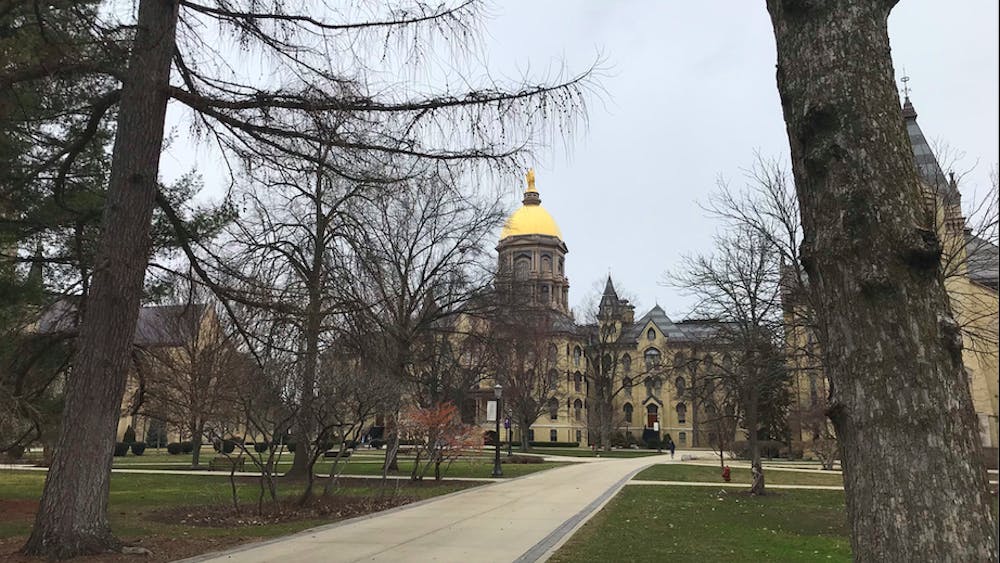Established in 1925, Morrissey Manor has been home to Notre Dame men for nearly a century. Part of the “Golden Coast” along with Lyons and Howard Halls on South Quad, the Manor’s elaborate architecture is among the most distinctive at Notre Dame.
Junior and incoming RA Brian Quigley explained some of the symbolism behind Morrissey’s iconic exterior in an email.
“[Morrissey] was intentionally built slightly asymmetric if you look at it closely, representing the fact that only God is truly perfect,” Quigley said. “It was named after Andrew Morrissey, the school’s seventh president. There is an X-shaped cross on the building that represents the crucifixion of St. Andrew, the patron saint of Fr. Morrissey.”

Morrissey Manor stands next to Howard and Lyons halls on South Quad.
Morrissey Manor stands next to Howard and Lyons halls on South Quad.
Morrissey houses around 180 “Manorites” from each year. The dorm hosts signature events such as the Medallion Hunt, essentially a giant scavenger hunt to find a medallion hidden somewhere on Notre Dame’s campus.
“The RAs and ARs that create the clues are usually very creative, and lots of people enjoy deciphering the clues and the hunt,” Quigley said.
Morrissey also hosted the very first outdoor game watch on South Quad for the Michigan State football game this year. Sophomore and hall president Ryan Doyle said that the game watch was a huge success and that Morrissey plans to continue this tradition in the future.
Another treasured tradition among the men of Morrissey is their basement food sales, Doyle said. The restaurant is called “Yaz’s” after Carl Yastrzemski, Hall of Fame baseball player for the Boston Red Sox and one of Morrissey’s more notable former residents. The profits from Yaz’s go to supporting Morrissey’s charity, the Hill School in Uganda.
“The food sales in the basement of Morrissey are super effective and raise a lot of money,” Doyle said. “All the profits go to charity.”
Morrissey is one of only three dorms on campus to not carry the title “hall,” along with Zahm House and Sorin College. In an email, rector Zack Imfeld shared a story he heard about how the Manor possibly came to be.
“An older Holy Cross priest stopped by one day and said he lived in Morrissey during the 1950s and when they decided to call themselves the Manor,” Imfeld said. “He said that the men were getting into a little bit of trouble, so they thought by naming their building a Manor, the men would hold themselves to a higher standard. From my experience, it worked — we have some of the best guys on campus!”
Morrissey is known for having the smallest rooms on campus, but Doyle said this is actually a positive quality because it increases fellowship among the residents. To make up for the small room sizes, there are large common rooms in each section that the residents can furnish as they choose.
“There’s a great community because very few people are spending the majority of their time in their room because it’s so small,” Doyle said. “People are forced out, and you get to meet pretty much everyone. I don’t know if there’s many people in Morrissey that I don’t know.”
Morrissey is the next dorm to be renovated, so its residents will be residing in Pangborn Hall next year. When asked how he felt the Morrissey community would respond to this change, Quigley expressed faith in the camaraderie of the Morrissey men to make it through the year.
“While we do love our building and we think it is beautiful and will miss it, we don’t really think that the building identifies us,” Quigley said. “The people in the dorm are what are important, and we will all still be together whether it is in the Manor or Pangborn. Our traditions will continue, and we will adapt in any way that we have to in order to grow our community and events.”









